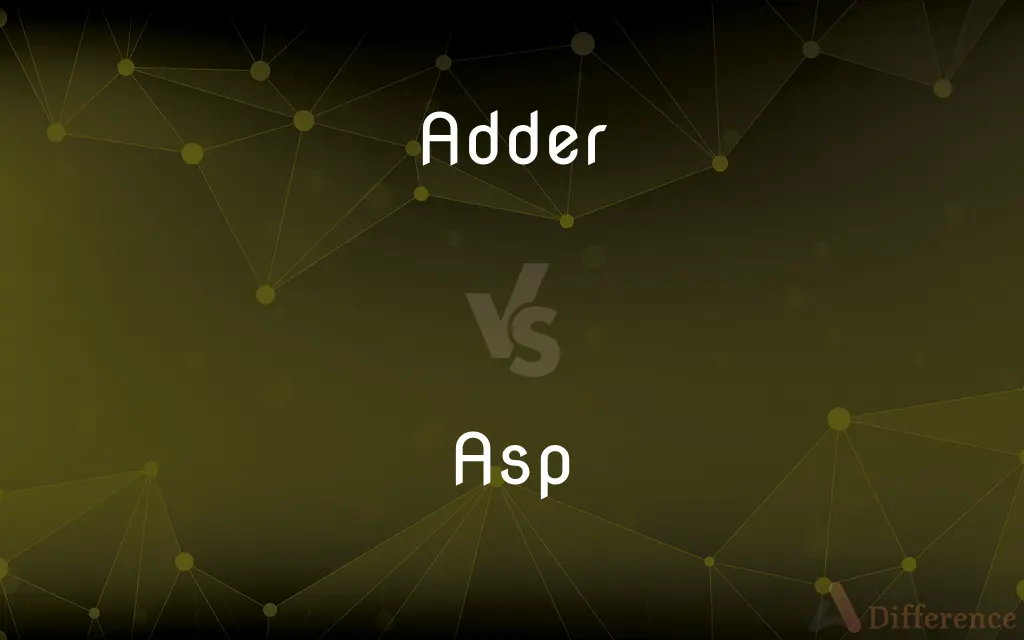Adder vs. Asp — What's the Difference?
By Tayyaba Rehman & Urooj Arif — Updated on March 27, 2024
Adder is a term primarily used for various snakes within the Vipera genus, known for their presence in Europe and Asia, while Asp commonly refers to the Egyptian cobra or sometimes the Vipera aspis in historical contexts.

Difference Between Adder and Asp
Table of Contents
ADVERTISEMENT
Key Differences
Adder refers to venomous snakes found mainly in Europe and parts of Asia, characterized by their distinct zigzag pattern. Whereas, the term Asp has historical significance, often associated with the Egyptian cobra used in ancient Egyptian symbolism and potentially lethal encounters.
While Adders are generally smaller, reaching up to 90 cm in length, and have a less potent venom compared to many other venomous snakes, Asps, especially the Egyptian cobra, can grow much larger and possess a more potent venom, which can be fatal to humans if untreated.
Adders, particularly the common European adder, are known for their preference for cooler climates and can be found in a variety of habitats including forests, meadows, and even near human settlements. On the other hand, Asps, such as the Egyptian cobra, are more adapted to arid environments like deserts and semi-desert regions in Africa.
Regarding behavior, Adders tend to be more reclusive and avoid human contact, striking only when threatened. Conversely, the Egyptian cobra can be more aggressive, displaying its iconic hood as a warning before striking when it feels threatened.
The term "Adder" can sometimes cause confusion as it is a common name applied to several different species within the Vipera genus and other unrelated snakes, whereas "Asp" is more specifically associated with the Egyptian cobra or historically with the Vipera aspis, leading to a clearer distinction in most contexts.
ADVERTISEMENT
Comparison Chart
Geographic Location
Europe and Asia
North Africa, especially Egypt
Typical Habitat
Forests, meadows, and human settlements
Arid environments like deserts and semi-desert regions
Size and Venom Potency
Generally smaller with less potent venom
Larger with more potent venom
Behavior
Reclusive, avoids humans, strikes only if threatened
Can display aggression, uses hood as a warning
Historical Significance
Primarily known in a natural context without much historical symbolism
Often associated with Egyptian history and symbolism
Compare with Definitions
Adder
Presence in cooler climates.
Adders are well-adapted to survive in the cooler climates of Northern Europe.
Asp
Symbol of sovereignty and royalty.
In ancient Egypt, the asp was a symbol of sovereignty and was worn by pharaohs.
Adder
A venomous snake.
The common European adder is the only venomous snake found in Britain.
Asp
Refers to the Egyptian cobra.
The asp, often depicted in ancient Egyptian art, is believed to be the Egyptian cobra.
Adder
Avoids confrontation.
Despite its venomous bite, the adder prefers to avoid confrontation with humans.
Asp
Adapted to arid environments.
Asps, such as the Egyptian cobra, thrive in the deserts of North Africa.
Adder
Variety within species.
The term 'adder' can refer to several species within the Vipera genus, adding to its biodiversity.
Asp
Historical significance.
The asp holds historical significance due to its association with famous historical figures and myths.
Adder
Zigzag pattern.
The distinctive zigzag pattern on the adder's back helps to identify it in its natural habitat.
Asp
Potentially lethal venom.
The asp's venom is highly toxic and can be lethal if antivenom is not administered promptly.
Adder
One that adds, especially a computational device that performs arithmetic addition.
Asp
Any of several venomous snakes, especially the viper Vipera aspis of southern Europe, the cobra Naja haje of Africa and the Middle East, or the horned viper.
Adder
Any of several venomous snakes, especially a viper of the subfamily Viperinae.
Asp
(archaic) A water snake.
Adder
Any of several nonvenomous snakes, such as the hognose snake, often believed to be harmful.
Asp
A venomous viper native to southwestern Europe (Vipera aspis).
Adder
(obsolete) Any snake.
Asp
The Egyptian cobra (Naja haje).
Adder
A name loosely applied to various snakes more or less resembling the viper.
Asp
(figurative) An evil person; a snake.
Adder
A small venomous serpent of the genus Vipera
Asp
A type of European fish (Aspius aspius).
Adder
The puff adders, of Africa (genus Bitis).
Asp
The aspen tree.
Adder
Any of several small nonvenomous snakes resembling adders
Asp
Same as Aspen.
Adder
Certain venomous snakes resembling other adders
Asp
A small, hooded, poisonous serpent of Egypt and adjacent countries, whose bite is often fatal. It is the Naja haje. The name is also applied to other poisonous serpents, esp. to Vipera aspis of southern Europe. See Haje.
Adder
A sea stickleback or adder fish (Spinachia spinachia).
Asp
A thorny shrub yielding a fragrant oil.
Adder
Someone who or something which performs arithmetic addition; a machine for adding numbers.
Asp
Of southern Europe; similar to but smaller than the adder
Adder
An electronic device that adds voltages, currents or frequencies.
Asp
Cobra used by the Pharaohs as a symbol of their power over life and death
Adder
Something which adds or increases.
They sought out cost adders with an eye toward eliminating them.
Adder
One who, or that which, adds; esp., a machine for adding numbers.
Adder
A serpent.
Adder
A small venomous serpent of the genus Vipera. The common European adder is the Vipera berus or Pelias berus. The puff adders of Africa are species of Clotho.
Adder
A person who adds numbers
Adder
A machine that adds numbers
Adder
Small terrestrial viper common in northern Eurasia
Common Curiosities
What is an Adder?
An adder is a venomous snake, primarily found in Europe and parts of Asia, known for its distinctive zigzag pattern.
Can Adders be found in urban areas?
Adders can sometimes be found near human settlements, although they generally prefer more natural habitats.
What is the significance of the Asp in history?
The asp has been historically significant, especially in ancient Egypt, where it symbolized sovereignty and divine authority.
What habitats do Asps prefer?
Asps, especially the Egyptian cobra, prefer arid environments like deserts and semi-desert regions.
What is an Asp?
An asp commonly refers to the Egyptian cobra, noted for its significant role in ancient Egyptian culture and mythology.
Why is the Asp associated with Egyptian royalty?
The asp is associated with Egyptian royalty due to its depiction with pharaohs and its symbolic representation of power.
What does the zigzag pattern on an Adder signify?
The zigzag pattern is a distinctive physical characteristic of adders, aiding in camouflage and identification.
How venomous are Adders?
Adders possess venom that is less potent compared to many venomous snakes, but can still be dangerous to humans if untreated.
Are all Adders venomous?
Yes, all snakes referred to as adders within the Vipera genus are venomous.
What differentiates an Adder from an Asp?
Adders are defined by their geographical presence in Europe and Asia and less potent venom, while Asps are associated with the Egyptian cobra, its potent venom, and historical significance.
How large can an Asp get?
Asps, such as the Egyptian cobra, can grow significantly large, with some individuals reaching lengths of more than 2 meters.
Are Adders aggressive?
Adders are not typically aggressive and tend to avoid human contact, striking only when directly threatened.
How does the Asp defend itself?
The asp, particularly the Egyptian cobra, can display aggressive behavior and will spread its hood as a warning before striking.
What role did the Asp play in ancient Egyptian culture?
The asp played a crucial role in ancient Egyptian culture, symbolizing protection, divine authority, and was often associated with the goddess Wadjet.
Can an Adder's bite be fatal?
An adder's bite can be dangerous and requires medical attention, but is rarely fatal to humans with prompt treatment.
Share Your Discovery

Previous Comparison
Period vs. Periodicity
Next Comparison
Wrath vs. WrothAuthor Spotlight
Written by
Tayyaba RehmanTayyaba Rehman is a distinguished writer, currently serving as a primary contributor to askdifference.com. As a researcher in semantics and etymology, Tayyaba's passion for the complexity of languages and their distinctions has found a perfect home on the platform. Tayyaba delves into the intricacies of language, distinguishing between commonly confused words and phrases, thereby providing clarity for readers worldwide.
Co-written by
Urooj ArifUrooj is a skilled content writer at Ask Difference, known for her exceptional ability to simplify complex topics into engaging and informative content. With a passion for research and a flair for clear, concise writing, she consistently delivers articles that resonate with our diverse audience.














































